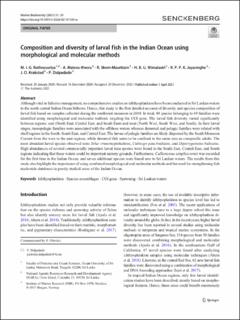| dc.description.abstract | Although vital in fisheries management, no comprehensive studies on ichthyoplankton have been conducted in Sri Lankan waters in the north central Indian Ocean hitherto. Hence, this study is the first detailed account of diversity and species composition of larval fish based on samples collected during the southwest monsoon in 2018. In total, 80 species belonging to 69 families were identified using morphological and molecular methods targeting the COI gene. The larval fish diversity varied significantly between regions: east (North East, Central East, and South East) and west (North West, South West, and South). In their larval stages, mesopelagic families were associated with the offshore waters whereas demersal and pelagic families were related with shelf regions in the South, South East, and Central East. The larvae of pelagic families are likely dispersed by the South Monsoon Current from the west to the east regions, while demersal fish seem to be confined to the same area as conspecific adults. The most abundant larval species observed were Selar crumenophthalmus, Cubiceps pauciradiatus, and Dipterygonotus balteatus. High abundances of several commercially important larval tuna species were found in the South East, Central East, and South regions indicating that these waters could be important nursery grounds. Furthermore, Callionymus simplicicornis was recorded for the first time in the Indian Ocean, and seven additional species were found new to Sri Lankan waters. The results from this study also highlight the importance of using combined morphological and molecular methods and the need for strengthening fish nucleotide databases in poorly studied areas of the Indian Ocean. | en_US |
